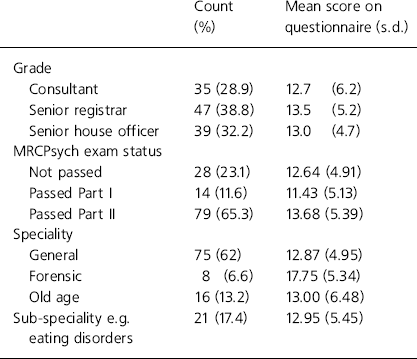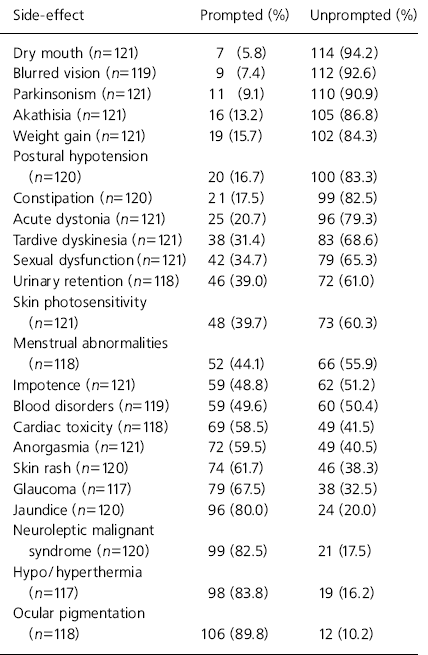Traditional antipsychotic medications have a wide range of adverse effects (British National Formulary, 1997) some of which have been found to occur more commonly than others, for example, extrapyramidal symptoms (Reference PeuskensPeuskens, 1995; Reference Tollefson, Beasley and TranTollefson et al 1997). Movement disorders are generally accepted to be the most common side-effects of antipsychotic medications, although it has been pointed out that other side-effects may be as common or as serious and thus as likely to cause non-adherence with medication (Reference Lidsky, Labuszewski and LevineLidsky et al, 1981).
Keown et al (Reference Keown, Slovic and Lichtenstein1984) found that lay-people were keen to be informed of all potential side-effects of medication. It has also been found that patient education about potential side-effects may be more likely to improve adherence rather than result in the patient refusing to take the drug (Reference Howland, Baker and PoeHowland et al, 1990). Chaplin et al (Reference Chaplin1998) found low rates of non-adherence in patients who attended educational sessions about the side-effects of antipsychotic drugs. Thus, it is possible that there is a link between lack of information about adverse effects and subsequent patient non-adherence. In order to investigate this, we tried to ascertain how much information doctors give to their patients about side-effects, by asking them which of the adverse effects of traditional antipsychotics they routinely discuss with patients and which side-effects they discuss only if the patient asks about them or complains of that side-effect.
The study
All doctors working clinically at a large mental health trust in south London, were sent a questionnaire asking them about the side-effects they routinely inform patients of when prescribing conventional antipsychotic medication, for example, chlorpromazine and haloperidol. Responses possible were: ‘always/sometimes’ (unprompted discussion) or ‘only if the patient asks of that side-effect’ (prompted discussion). A score of one was given for unprompted discussion, a score of zero for prompted discussion. This gave an overall total score which could range from 0-23. For example, a score of 15 indicates that that doctor informs patients about 15 of the listed adverse effects, without prompting, most of the time. Doctors who failed to return questionnaire within four weeks were sent a further copy. The speciality, years working in psychiatry, membership of the Royal College and grade were noted for each doctor.
Findings
One hundred and twenty-one questionnaires were returned out of a total of 205 (59%). Breakdown of the speciality, years in psychiatry and membership of the Royal College of Psychiatrists can be seen in Table 1.
Table 1 Characteristics of doctors responding to questionnaires

| Count (%) | Mean score on questionnaire (s.d.) | |
|---|---|---|
| Grade | ||
| Consultant | 35 (28.9) | 12.7 (6.2) |
| Senior registrar | 47 (38.8) | 13.5 (5.2) |
| Senior house officer | 39 (32.2) | 13.0 (4.7) |
| MRCPsych exam status | ||
| Not passed | 28 (23.1) | 12.64 (4.91) |
| Passed Part I | 14 (11.6) | 11.43 (5.13) |
| Passed Part II | 79 (65.3) | 13.68 (5.39) |
| Speciality | ||
| General | 75 (62) | 12.87 (4.95) |
| Forensic | 8 (6.6) | 17.75 (5.34) |
| Old age | 16 (13.2) | 13.00 (6.48) |
| Sub-speciality e.g. eating disorders | 21 (17.4) | 12.95 (5.45) |
No significant differences were found between different grades with regard to overall scores on the questionnaire. However, senior registrars reported giving more information than senior house officers/registrars, who reported giving more information than consultants. Forensic specialists reported informing patients of more side-effects than other specialists, and this approached significance (P=0.06), but numbers were very small. There was no correlation between score on the questionnaire and length of time in psychiatry, being a member of the College or grade.
Table 2 shows the side-effects of conventional medications with the numbers of doctors who discuss each side-effect either unprompted (sometimes or always) or prompted (only if the patient asks or complains). Some of the questionnaires were filled out incompletely, so in the case of certain side-effects there were less than 121 responses.
Table 2 Side-effects of conventional antipsychotic medications

| Side-effect | Prompted (%) | Unprompted (%) |
|---|---|---|
| Dry mouth (n=121) | 7 (5.8) | 114 (94.2) |
| Blurred vision (n=119) | 9 (7.4) | 112 (92.6) |
| Parkinsonism (n=121) | 11 (9.1) | 110 (90.9) |
| Akathisia (n=121) | 16 (13.2) | 105 (86.8) |
| Weight gain (n=121) | 19 (15.7) | 102 (84.3) |
| Postural hypotension (n=120) | 20 (16.7) | 100 (83.3) |
| Constipation (n=120) | 21 (17.5) | 99 (82.5) |
| Acute dystonia (n=121) | 25 (20.7) | 96 (79.3) |
| Tardive dyskinesia (n=121) | 38 (31.4) | 83 (68.6) |
| Sexual dysfunction (n=121) | 42 (34.7) | 79 (65.3) |
| Urinary retention (n=118) | 46 (39.0) | 72 (61.0) |
| Skin photosensitivity (n=121) | 48 (39.7) | 73 (60.3) |
| Menstrual abnormalities (n=118) | 52 (44.1) | 66 (55.9) |
| Impotence (n=121) | 59 (48.8) | 62 (51.2) |
| Blood disorders (n=119) | 59 (49.6) | 60 (50.4) |
| Cardiac toxicity (n=118) | 69 (58.5) | 49 (41.5) |
| Anorgasmia (n=121) | 72 (59.5) | 49 (40.5) |
| Skin rash (n=120) | 74 (61.7) | 46 (38.3) |
| Glaucoma (n=117) | 79 (67.5) | 38 (32.5) |
| Jaundice (n=120) | 96 (80.0) | 24 (20.0) |
| Neuroleptic malignant syndrome (n=120) | 99 (82.5) | 21 (17.5) |
| Hypo/hyperthermia (n=117) | 98 (83.8) | 19 (16.2) |
| Ocular pigmentation (n=118) | 106 (89.8) | 12 (10.2) |
Dry mouth, blurred vision and Parkinsonism were the most frequently discussed side-effects, with weight gain, blood disorders, jaundice and temperature regulation problems being discussed less often. There was a marked discrepancy in the frequency of the type of discussion of different side-effects. This can be seen in Table 3, which shows the percentage of time spent on either prompted or unprompted discussion for each set of side-effects. This was produced by grouping together individual side-effects and for each group summing the reports of prompted or unprompted discussion, then dividing by the total number of opportunities for discussion, for example, anticholinergic affect being discussed unprompted was 114+112+99+72=397; 397/(121+121+118)=397/480=82.7%. Thus, doctors reported that when they discuss anticholinergic side-effects, 83% of the time they did so without the patients having to ask.
Table 3 Percentage prompted/unprompted discussion of different groups of side-effects

| Side-effect group | Prompted | Unprompted |
|---|---|---|
| Anticholinergic | 17% | 83% |
| Extrapyramidal | 18% | 82% |
| Cardiovascular | 37% | 63% |
| Sexual dysfunction | 48% | 52% |
Comment
We must draw attention to the limitations of the study. It is a purely descriptive study relying on honest reporting by doctors. This is perhaps a poor proxy for actually being present at a consultation. The response rate was only 59% and we do not know the habits of those who did not return the questionnaires which may be quite different to those of the responding doctors. The study took place at a large teaching trust with a high proportion of middle grade doctors which may make the sample unrepresentative. How reliable the responses were might be questioned given that 10% claimed to routinely tell their patients about ocular pigmentation and one in three routinely discuss glaucoma!
The indications of this study are that doctors report that they do inform patients about the adverse effects of medication, but it appears they are highly selective with regard to which side-effects they feel ready to discuss with patients.
Anticholinergic and extrapyramidal side-effects are generally considered to be the most commonly occurring side-effects, most likely to result in non-adherence if they occur without the patient having some under-standing of why they occur and how to combat them. However, other side-effects such as cardiac effects, weight gain and sexual side-effects have been found to be very troublesome and common (Reference KeksKeks, 1996). That these side-effects may be causes of non-adherence has yet to be investigated. Tollefson et al (Reference Tollefson, Beasley and Tran1997) found weight gain to be one of the most frequent patient complaints, more so than the extrapyramidal side-effects. Cardiac toxicity has been implicated in many of the non-deliberate sudden deaths associated with neuroleptic medications (Reference Warner, Barnes and HenryWarner et al, 1996), yet it appears from this study that doctors are relatively unlikely to inform patients of these potentially fatal adverse effects.
It seems logical that side-effects which are felt to be less common are less frequently discussed with patients, such as skin photosensitivity and menstrual dysfunction, however, it is possible that clinicians underestimate the prevalence of these side-effects as patients do not complain.
This study highlights the selectivity of information given to patients by doctors about their medication. Clearly prospective studies need to be done to investigate the possibility that there may be differences in perception between doctors and patients with regard to the importance of side-effects and also to research the relationship between iatrogenic antipsychotic-induced dysfunction and non-adherence. The important first step, however, should be to improve the discussions with patients about the side-effects of antipsychotic drugs.






eLetters
No eLetters have been published for this article.